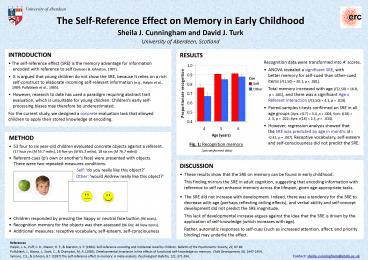The Self-Reference Effect on Memory in Early Childhood - PowerPoint PPT Presentation
1 / 1
Title:
The Self-Reference Effect on Memory in Early Childhood
Description:
University of Aberdeen The Self-Reference Effect on Memory in Early Childhood Sheila J. Cunningham and David J. Turk University of Aberdeen, Scotland – PowerPoint PPT presentation
Number of Views:31
Avg rating:3.0/5.0
Title: The Self-Reference Effect on Memory in Early Childhood
1
University of Aberdeen
The Self-Reference Effect on Memory in Early
Childhood Sheila J. Cunningham and David J. Turk
University of Aberdeen, Scotland
- INTRODUCTION
- The self-reference effect (SRE) is the memory
advantage for information - encoded with reference to self (Symons
Johnston, 1997). - It is argued that young children do not show
the SRE, because it relies on a rich - self-construct to elaborate incoming
self-relevant information (e.g., Halpin et al., - 1984 Pullyblank et al., 1985).
- However, research to date has used a paradigm
requiring abstract trait - evaluation, which is unsuitable for young
children. Childrens early self- - processing biases may therefore be
underestimated. - For the current study, we designed a concrete
evaluation task that allowed children to apply
their stored knowledge at encoding.
RESULTS Fig. 1 Recognition
memory (untransformed data)
- Recognition data were transformed into A scores.
- ANOVA revealed a significant SRE, with
- better memory for self-cued than other-cued
- items (F(1,50) 20.1, p lt .001).
- Total memory increased with age (F(2,50)
16.8, - p lt .001), and there was a significant Age
x - Referent interaction (F(2,50) 4.3, p
.019). - Paired-samples t-tests confirmed an SRE in all
- age groups (4yrs t(17) 3.4, p .004
5yrs t(18) - 2. 5, p .022 6yrs t(18) 2.3, p
.034). - However, regression analysis showed that
- the SRE was predicted by age in months (ß
- -0.42, p .007). Receptive vocabulary,
self-esteem - and self-consciousness did not predict the
SRE.
- METHOD
- 53 four to six year-old children evaluated
concrete objects against a referent. - (17 four yrs (M 55.7 mths), 18 five yrs (M
65.3 mths), 18 six yrs (M 76.7 mths)) - Referent-cues (ps own or anothers face) were
presented with objects. - There were two repeated-measures conditions
-
Self do you really like this
object? - Other would
Andrew really like this object? -
- Children responded by pressing the happy or
neutral face button (96 trials). - Recognition memory for the objects was then
assessed (96 Old, 48 New items). - Additional measures receptive vocabulary,
self-esteem, self-consciousness
- DISCUSSION
- These results show that the SRE on memory can
be found in early childhood. - This finding mirrors the SRE in adult
cognition, suggesting that encoding information
with - reference to self can enhance memory across
the lifespan, given age-appropriate tasks. - The SRE did not increase with development.
Indeed, there was a tendency for the SRE to - decrease with age (perhaps reflecting ceiling
effects), and verbal ability and self-concept - development did not predict the SRE
magnitude. - This lack of developmental increase argues
against the idea that the SRE is driven by the - application of self-knowledge (which
increases with age). - Rather, automatic responses to self-cues
(such as increased attention, affect, and
priority - binding) may underlie the effect.
References Halpin, J. A., Puff, C. R., Mason, H.
F., Marston, S. P. (1984). Self-reference
encoding and incidental recall by children.
Bulletin of the Psychonomic Society, 22, 87-89.
Pullyblank, J., Bisanz, J., Scott, C.,
Champion, M. A. (1985). Developmental invariance
in the effects of functional self-knowledge on
memory. Child Development, 56, 1447-1454.
Symons, C.S., Johnson, B.T. (1997).The
self-reference effect in memory A meta-analysis.
Psychological Bulletin, 121, 371-394.
Contact sheila.cunningham_at_abdn.ac.uk































